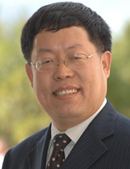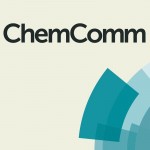The 25 most-downloaded ChemComm articles in the first quarter of 2015 were as follows:
Nanoimaging of localized plasmon-induced charge separation
Emiko Kazuma, Nobuyuki Sakai and Tetsu Tatsuma
Chem. Commun., 2011,47, 5777-5779
DOI: 10.1039/C1CC10936G, Communication
Glucose transport machinery reconstituted in cell models
Jesper S. Hansen, Karin Elbing, James R. Thompson, Noah Malmstadt and Karin Lindkvist-Petersson
Chem. Commun., 2015,51, 2316-2319
DOI: 10.1039/C4CC08838G, Communication
An engineered lantipeptide synthetase serves as a general leader peptide-dependent kinase
Gabrielle N. Thibodeaux and Wilfred A. van der Donk
Chem. Commun., 2012,48, 10615-10617
DOI: 10.1039/C2CC34138G, Communication
A solvent-free Diels–Alder reaction of graphite into functionalized graphene nanosheets
Jeong-Min Seo and Jong-Beom Baek
Chem. Commun., 2014,50, 14651-14653
DOI: 10.1039/C4CC07173E, Communication
Nanostructured electrochromic smart windows: traditional materials and NIR-selective plasmonic nanocrystals
Evan L. Runnerstrom, Anna Llordés, Sebastien D. Lounis and Delia J. Milliron
Chem. Commun., 2014,50, 10555-10572
DOI: 10.1039/C4CC03109A, Feature Article
Production of few-layer phosphorene by liquid exfoliation of black phosphorus
Jack R. Brent, Nicky Savjani, Edward A. Lewis, Sarah J. Haigh, David J. Lewis and Paul O’Brien
Chem. Commun., 2014,50, 13338-13341
DOI: 10.1039/C4CC05752J, Communication
Polydiacetylenes: supramolecular smart materials with a structural hierarchy for sensing, imaging and display applications
Oktay Yarimaga, Justyn Jaworski, Bora Yoon and Jong-Man Kim
Chem. Commun., 2012,48, 2469-2485
DOI: 10.1039/C2CC17441C, Feature Article
Hydrogen storage properties and neutron scattering studies of Mg2(dobdc)—a metal–organic framework with open Mg2+ adsorption sites
Kenji Sumida, Craig M. Brown, Zoey R. Herm, Sachin Chavan, Silvia Bordiga and Jeffrey R. Long
Chem. Commun., 2011,47, 1157-1159
DOI: 10.1039/C0CC03453C, Communication
From themed collection Hydrogen
A high-throughput screening method for determining the substrate scope of nitrilases
Gary W. Black, Nicola L. Brown, Justin J. B. Perry, P. David Randall, Graeme Turnbull and Meng Zhang
Chem. Commun., 2015,51, 2660-2662
DOI: 10.1039/C4CC06021K, Communication
Enhancement of cyclization quantum yields of perfluorodiarylethenes via weak intramolecular interactions
Shouzhi Pu, Chunhong Zheng, Qi Sun, Gang Liu and Congbin Fan
Chem. Commun., 2013,49, 8036-8038
DOI: 10.1039/C3CC44348E, Communication
Rapid ultrasonic isothermal amplification of DNA with multiplexed melting analysis – applications in the clinical diagnosis of sexually transmitted diseases
Gaolian Xu, Rory N. Gunson, Jonathan M. Cooper and Julien Reboud
Chem. Commun., 2015,51, 2589-2592
DOI: 10.1039/C4CC08389J, Communication
A zirconium squarate metal–organic framework with modulator-dependent molecular sieving properties
Bart Bueken, Helge Reinsch, Nele Reimer, Ivo Stassen, Frederik Vermoortele, Rob Ameloot, Norbert Stock, Christine E. A. Kirschhock and Dirk De Vos
Chem. Commun., 2014,50, 10055-10058
DOI: 10.1039/C4CC03764B, Communication
Highly sensitive detection of self-aggregated single-walled carbon nanotubes using a DNA-immobilized resonator
Kuewhan Jang, Jinsung Park, Doyeon Bang, Sangmyung Lee, Juneseok You, Seungjoo Haam and Sungsoo Na
Chem. Commun., 2013,49, 8635-8637
DOI: 10.1039/C3CC42911C, Communication
Selective glucose recognition by boronic acid azoprobe/γ-cyclodextrin complexes in water
Chie Shimpuku, Rimiko Ozawa, Akira Sasaki, Fuyuki Sato, Takeshi Hashimoto, Akiyo Yamauchi, Iwao Suzuki and Takashi Hayashita
Chem. Commun., 2009, 1709-1711
DOI: 10.1039/B819938H, Communication
Nickel-catalyzed borylation of arenes and indoles via C–H bond cleavage
Takayuki Furukawa, Mamoru Tobisu and Naoto Chatani
Chem. Commun., 2015,51, 6508-6511
DOI: 10.1039/C5CC01378J, Communication
Graphene quantum dots: emergent nanolights for bioimaging, sensors, catalysis and photovoltaic devices
Jianhua Shen, Yihua Zhu, Xiaoling Yang and Chunzhong Li
Chem. Commun., 2012,48, 3686-3699
DOI: 10.1039/C2CC00110A, Feature Article
Enhanced stability and activity of Pt–Y alloy catalysts for electrocatalytic oxygen reduction
Sung Jong Yoo, Soo-Kil Kim, Tae-Yeol Jeon, Seung Jun Hwang, June-Gunn Lee, Seung-Cheol Lee, Kug-Seung Lee, Yong-Hun Cho, Yung-Eun Sung and Tae-Hoon Lim
Chem. Commun., 2011,47, 11414-11416
DOI: 10.1039/C1CC12448J, Communication
Synthesis and characterization of dithienylbenzobis(thiadiazole)-based low band-gap polymers for organic electronics
Heong Sub Oh, Tae-Dong Kim, Yun-Hyuk Koh, Kwang-Sup Lee, Shinuk Cho, Alex Cartwright and Paras N. Prasad
Chem. Commun., 2011,47, 8931-8933
DOI: 10.1039/C1CC11899D, Communication
Aggregation-induced emission: phenomenon, mechanism and applications
Yuning Hong, Jacky W. Y. Lam and Ben Zhong Tang
Chem. Commun., 2009, 4332-4353
DOI: 10.1039/B904665H, Feature Article
Construction of a supported Ru complex on bifunctional MOF-253 for photocatalytic CO2 reduction under visible light
Dengrong Sun, Yanhong Gao, Jinlong Fu, Xianchong Zeng, Zhongning Chen and Zhaohui Li
Chem. Commun., 2015,51, 2645-2648
DOI: 10.1039/C4CC09797A, Communication
Chemical synthesis of magnetic nanoparticles
Taeghwan Hyeon
Chem. Commun., 2003, 927-934
DOI: 10.1039/B207789B, Feature Article
Multifunctional catalysis by Pd-polyoxometalate: one-step conversion of acetone to methyl isobutyl ketone
Robert D. Hetterley, Elena F. Kozhevnikova and Ivan V. Kozhevnikov
Chem. Commun., 2006, 782-784
DOI: 10.1039/B515325E, Communication
Reduction of graphene oxide viaL-ascorbic acid
Jiali Zhang, Haijun Yang, Guangxia Shen, Ping Cheng, Jingyan Zhang and Shouwu Guo
Chem. Commun., 2010,46, 1112-1114
DOI: 10.1039/B917705A, Communication
Naphthalene and perylene diimides for organic transistors
Frank Würthner and Matthias Stolte
Chem. Commun., 2011,47, 5109-5115
DOI: 10.1039/C1CC10321K, Highlight
From themed collection Highlights in Chemistry
Wet chemical synthesis of silver nanorods and nanowires of controllable aspect ratio
Nikhil R. Jana, Latha Gearheart and Catherine J. Murphy
Chem. Commun., 2001, 617-618
DOI: 10.1039/B100521I, Communication
These articles are all free to download until 6th July. Access is free through a registered RSC account – click here to register
ChemComm is the home of urgent high quality communications from across the chemical sciences. With a world renowned reputation for quality and fast times to publication (average of 40 days), ChemComm is the ideal place to publish your research.
Submit your urgent research to ChemComm today!
Stay up to date with ChemComm
Be among the first to hear about the newest articles being published – Sign-up to our journal news alert to receive information about most read articles, themed issues, journal news, as well as calls for papers and invitations.














 US scientists have developed
US scientists have developed 


 Tweaking the natural substrates of terpene synthase enzymes could
Tweaking the natural substrates of terpene synthase enzymes could 